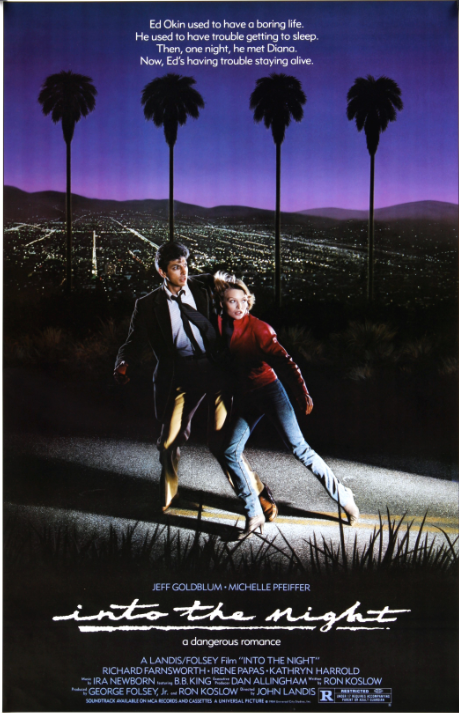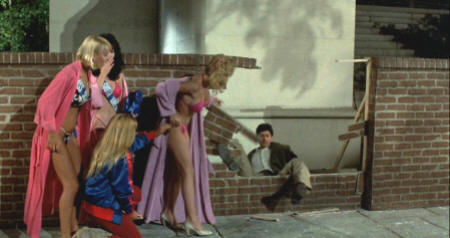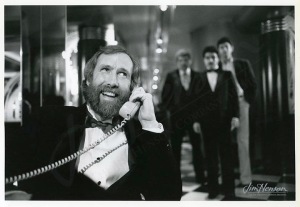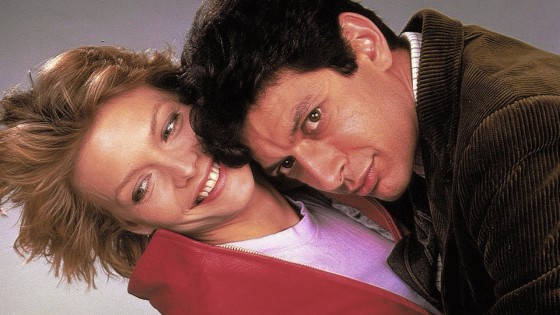Inspired by this films recommendation on "
The Forgotten Filmcast" I have slipped this in a bit earlier than it was scheduled to show up. This is another of my "Movies I Want Everyone to See" series that was originally published on the defunct site "Fogs Movie Reviews" in the Fall of 2013.

Review by Richard Kirkham
"Into
the Night" is a film that I recommend for a somewhat narrow range of
reasons. Although it is referred to as a comedy, action, thriller, it
barely qualifies in each of those categories. Don't get me wrong, there
is a lot that is funny about the movie, and there is some action and
tension along the way, and what could be more thrilling than seeing
Michelle Pfeiffer at the peak of her beauty and charm? The real reason
to see this movie however is the tour of Southern California culture
from the 1980s that you get along the way. It is a very loose film with
some nice sequences and dialogue but as a film it seems to lurch forward
and wander around the story at times, but oh what interesting times.


An
essay over at A.V. Club, classifies this film and several others, as
films which fit into a particular genre, actually called into the night
films. The classification is based first on story line. The lead
disappears into another subculture, usually starting with a night time
excursion. The second point the essay suggests is that these mostly
eighties films are sociological examinations of the conflict that the
baby boomer generation feels over the rejection of the values championed
by the counter culture of the 1960 and 70s by the preponderant culture
in the 1980s. It is an interesting point and as a paper submitted in a
graduate writing class in Cinema, it probably scored the author an A.
Let's extend their point for one more comment, all of the films that
were mentioned (with the exception of two John Hughes films which
probably don't fit) were culturally marginal as well.

When this
film was released it received quite negative reviews from the critics.
The New York Times was very dismissive but Roget Ebert went one step
further, giving the film a single star rating on his scale. Both reviews
focused on the insider nature of
the movie. The film features cameo appearances by a variety of
Hollywood types, including at least 17 film directors. The suggestion
here is that the film was mostly an excuse to get a bunch of friends
together and have an extended party at the studio's expense. It is not
possible to say for sure that this was not the case, but it can be said
that those guest shots are not distracting from the movie. While
sometimes the interjection of these actors, directors and writers did
turn the movie into a game of "spot the hidden celebrity", that added to
the fun of the premise and emphasized what the movie is about. The
subject here is Hollywood itself.

A quick plot summary: Ed Okin is
an aerospace engineer suffering from insomnia and job burnout. After he
discovers his marriage is even less than he thought it to be, he drives
to the airport to clear his thoughts, maybe with the idea of going to
Vegas for the night. Just as he starts to fall asleep in his car in the
parking structure, a woman screams, jumps on the hood of his car and
asks for help. Men are chasing her and guns are blazing and he reacts
instinctively by driving her off. That woman is Diana and it turns out
she is involved in a smuggling escapade. The two of them travel around
Los Angeles for the next twenty-four hours, trying to figure a way out
of the predicament they have become trapped in.
The plot involves Elvis impersonators, high stakes gambling,film
production, real estate, high end shopping and the fall of the Shah of
Iran. As you can tell, the movie meanders and touches on lots of
different elements.
Here is the real deal for you though. You have
to pay close attention because it is not front and center of the movie.
The subject of the film is how the City and the Hollywood community
work. Jeff Goldblum's character Ed, is an engineer in an industry in
Southern California that the Hollywood people think is boring. They show
him at his job, being disinterested, he complains about not caring
himself. To the showbiz world, this validates their view of themselves.
Unlike Ed, "We are exciting", "We are different every day". Diana is a
beautiful woman who came to Southern California in all likelihood to be a
star. Instead she falls into a relationship with a rich older man.
There is a cliche of Hollywood that you can see everyday as you drive
through town. Later, the older man seems to discard her, another
Southern California dream gone bad.

As you watch the film
progress, you get a travelogue of L.A. area haunts, usually of the rich.
The yacht of Diana's older lover is in Marina Del Rey. She and Ed visit
a set in Hollywood and meet up with one of her friends who got into the
Biz, by sleeping with the producer. They suffer the indignity of being
escorted off the set and of being rejected by her brother, whose
connection to the entertainment business is as an Elvis impersonator.
Later in the film they stroll through Beverly Hills shopping district
and spend some time in the Beverly Wilshire Hotel.
There is a car chase through Century City, in that most annoying of
L.A. locations, a multi-storied underground parking garage. If you are
from the Southland you know that a parking garage is a necessary
anathema. This is a car culture and Ed and Diana end up in the most
unlikely vehicle in L.A., a taxi. To make matters worse, the taxi is
chased through a parking garage which residents hate, since free parking
was at one time a birthright of Angeleno's (those days are long gone).
It wouldn't be L.A. if there were not a beach scene, so we get a murder
in Malibu. The whole movie is really a critique of the L.A. lifestyle.

Everywhere
in the movie are L.A. references. In the opening sequences there are
radio shows playing in the background and defining what the radio was
like in Southern California. People from out of the area will not
understand why they are watching references to car salesmen in
commercials. Pete Ellis was ubiquitous on TV at the time, he had car
dealerships in all the major American brands at some point or another.
Most of you probably have a commercial jingle or two stuck in your head.
Those earworms are often a result of repetition. "Pete Ellis Dodge,
Long Beach Freeway, Firestone Exit, South Gate." It doesn't sound all
that memorable, but you put a catchy tune behind it and play it fifty
times a day on the local TV stations it will be. Twenty five years after
that dealership went away, the sound is still ringing in my head. Cal
Worthington is famous in So. Cal for his silly TV commercials where he
mocked another car dealer who put his dog in commercials selling cars.
Cal's dog "Spot" was a tiger, an elephant, a killer whale. He would do
really loopy things like wing walking and then put them in the ads.
"Into the Night" is filled with those late night TV ads in the
backgrounds of several scenes.

Another
odd reference to show business, is a fight to the death between two
characters played by Rock and Roll Hall of Famers Carl Perkins and David
Bowie. This was Perkins only screen appearance and he is a natural.
Bowie of course had made several movies at that point and several more
since. In the sequence where they face off, the TV is running in the
background, playing an old Abbott and Costello movie. So two icons of
pop music are dueling for attention with classic comedians who made
movies. It is an odd juxtaposition but typical of this movie, directed
by John Landis, a fan of horror films especially. If you were not aware
of it, Landis uses the phrase "See You Next Wednesday" as a signature in
all of his movies.
Here it is on movie posters in the trailer that Ed and Diana get
escorted out of. The line comes from Kubrick's "2001". It is no accident
that movie references populate this film, even to the point of
providing a distraction from a violent fight scene.
There are
extended segments in Beverly Hills, both in the shopping district and in
the residential neighborhoods. Fans of "Chinatown" know that the plot
of that classic is mostly a giant real estate swindle, well it turns out
that this movie is heavily involved in that same business. The jewels
are supposed to help secure financing for a real estate deal being
pursued by rich "Iranian" refugees. Large numbers of said refugees found
homes in Beverly Hills and so the sound of Farsi being spoken in the
stylish salons of Rodeo Drive was not unusual. It turns out that Jack,
Diana's rich patron, is also involved in real estate and that brings
some strings of the plot together at the end.

The end of the film
takes place at the location that most visitors first encounter the city,
the Airport. LAX is always busy but we don't typically have shoot outs
there (although it has happened).
The odd way in which the stand off resolves itself is again spurred on
by Ed's manner. Through the whole picture Jeff Goldblum plays Ed as if
he is exhausted and can barely be bothered to respond to the events
taking place around him. The casualness is another one of those L.A.
critiques, nothing really seems important to anyone, except the
business. The rich and powerful control the political process, the lower
level functionaries are corrupt, and the beautiful people get to make
their own rules.
"Into the Night" is not an essential movie, but
it is one that I always want people to see because it is a tour of the
world that I lived in at the time. It features an odd leading man, and a
beautiful leading lady, wandering around the city that I both love and
hate. There are plenty of amusing bits and pieces that often have
nothing to do with the story, they are just a chance to visit at a
touchstone of 80s L.A. culture. The scene at Ships Coffee Shop has
nothing to do with the story, and everything to do with where you can go
in the middle of the night to get dessert. There is no reason to hide
the jewels at the flower market, except that then viewers will get a
chance to see the flower market. Jake Steiner is in the movie because he
turned being a trainer for Harrison Ford into a career as a pitchman
for physical fitness (and getting into the business). A movie with a
different plot but a very similar look at L.A. almost fifteen years
earlier is "Hickey and Bogs". In the place of Goldblum and Pfeiffer, are
Bill Cosby and Robert Culp. Maybe it will justify a little analysis
down the road, right now I mention it just wanted to show that these
sorts of films do repeat themselves and reflect the changes of the city
over time. "Get Shorty" in the 1990s and this years "This is the End"
cover the same themes. A lot of bad stuff can happen here but if you
make it in the movie business , you'll be alright.

Richard
Kirkham is a lifelong movie enthusiast from Southern California. While
embracing all genres of film making, he is especially moved to write
about and share his memories of movies from his formative years, the
glorious 1970s. His personal blog, featuring current film reviews as
well as his Summers of the 1970s movie project, can be found at
Kirkham A Movie A Day. 


















 Chuck
Yeager, the man who broke the sound barrier is the main hero in the
film, despite the fact that he is limited in the amount of screen time
his character receives. Yeager is the real deal, last year on the 65th
anniversary of the sound barrier breakthrough, he repeated the
experience, at age 89. In the movie he is portrayed by playwright and
actor Sam Shepard. The part earned him an Academy Award Nomination as a
quiet man who had a keener sense of the destiny of manned space flight
than many of those in the space program itself. (Look for the real Chuck
Yeager in the bit part of Fred, the barman at the Happy Bottom Riding
Club.) The other breakout role belongs to Ed Harris playing John Glenn.
We get to understand Glenn's quiet charisma through Harris' subtle
work. The one scene where he breaks out in a human conflict works
because he has been such a steady and quiet presence through most of the
film up until that point.
Chuck
Yeager, the man who broke the sound barrier is the main hero in the
film, despite the fact that he is limited in the amount of screen time
his character receives. Yeager is the real deal, last year on the 65th
anniversary of the sound barrier breakthrough, he repeated the
experience, at age 89. In the movie he is portrayed by playwright and
actor Sam Shepard. The part earned him an Academy Award Nomination as a
quiet man who had a keener sense of the destiny of manned space flight
than many of those in the space program itself. (Look for the real Chuck
Yeager in the bit part of Fred, the barman at the Happy Bottom Riding
Club.) The other breakout role belongs to Ed Harris playing John Glenn.
We get to understand Glenn's quiet charisma through Harris' subtle
work. The one scene where he breaks out in a human conflict works
because he has been such a steady and quiet presence through most of the
film up until that point.
 There are some
incredibly iconic moments in the film. There may have been earlier uses
of the shot, but this was the first time I remember seeing the men
walking abreast toward
the camera shot in this manner. Clearly when they are all in their
flight suits and helmets, moving down the long hallway, we have some men
on a mission. Those men can be seen to be serious. The shot has been
done a thousand times since and it is parodied quite often as well but
this was the first time I can say I was impressed by the idea. I won't
say it was invented here but I will say it was perfected.
There are some
incredibly iconic moments in the film. There may have been earlier uses
of the shot, but this was the first time I remember seeing the men
walking abreast toward
the camera shot in this manner. Clearly when they are all in their
flight suits and helmets, moving down the long hallway, we have some men
on a mission. Those men can be seen to be serious. The shot has been
done a thousand times since and it is parodied quite often as well but
this was the first time I can say I was impressed by the idea. I won't
say it was invented here but I will say it was perfected.









